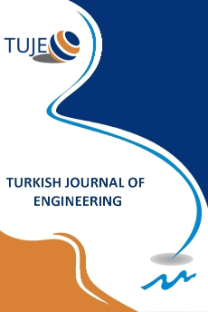Image processing based autonomous landing zone detection for a multi-rotor drone in emergency situations
autonomous landing, image processing, object detection, UAV,
___
- AMAZON (2017). Prime Air. from https://www.amazon.com/Amazon-Prime-Air/b?ie=%20UTF8&node=8037720011.
- Aydin B, Selvi E, Tao J & Starek M (2019). Use of Fire-Extinguishing Balls for a Conceptual System of Drone-Assisted Wildfire Fighting. Drones, 3(1). https://doi.org/10.3390/drones3010017
- Barták R, Hraško A & Obdržálek D (2014). On autonomous landing of AR.Drone: Hands-on experience. Proceedings of the 27th International Florida Artificial Intelligence Research Society Conference, FLAIRS 2014: 400-405.
- Cabrera-Ponce A A & Martinez-Carranza J (2017). A vision-based approach for autonomous landing. 2017 Workshop on Research, Education and Development of Unmanned Aerial Systems (RED-UAS). Linköping, Sweden. DOI: 10.1109/RED-UAS.2017.8101655
- Canny J (1986). A Computational Approach to Edge Detection. IEEE Transactions on Pattern Analysis and Machine Intelligence PAMI-8(6): 679-698. DOI: 10.1109/TPAMI.1986.4767851
- Chen W, Yue H, Wang J & Wu X (2014). An improved edge detection algorithm for depth map inpainting. Optics and Lasers in Engineering, 55: 69–77. https://doi.org/10.1016/j.optlaseng.2013.10.025
- Fitzgerald D & Walker R (2005). Classification of Candidate Landing Sites for UAV Forced Landings. AIAA Guidance, Navigation, and Control Conference and Exhibit, San Francisco, California.
- Fitzgerald D, Walker R & Campbell D (2005). A Vision Based Emergency Forced Landing System for an Autonomous UAV. Australian International Aerospace Congress, Melbourne, Australia.
- Guo X, Denman S, Fookes C, Mejias L & Sridharan S (2014). Automatic UAV Forced Landing Site Detection Using Machine Learning. 2014 International Conference on Digital Image Computing: Techniques and Applications (DICTA). Wollongong, NSW, Australia. DOI: 10.1109/DICTA.2014.7008097
- Heincke B, Jackisch R, Saartenoja A, Salmirinne H, Rapp S, Zimmermann R, Pirttijärvi M et al. (2019). Developing multi-sensor drones for geological mapping and mineral exploration: setup and first results from the MULSEDRO project. Geological Survey of Denmark and Greenland Bulletin 43. https://doi.org/10.34194/GEUSB-201943-03-02
- Ho H W (2017). Autonomous landing of Micro Air Vehicles through bio-inspired monocular vision. PHD Thesis, ISBN: 978-94-6186-818-3
- Hoffmann G M, Huang H, Waslander S L & Tomlin C (2007). Quadrotor Helicopter Flight Dynamics and Control: Theory and Experiment. AIAA Guidance, Navigation and Control Conference and Exhibit, South Carolina
- Jakob S, Zimmermann R & Gloaguen R (2016). Processing of drone-borne hyperspectral data for geological applications. 2016 8th Workshop on Hyperspectral Image and Signal Processing: Evolution in Remote Sensing (WHISPERS). Los Angeles, CA, USA. DOI: 10.1109/WHISPERS.2016.8071689
- Kim J & Sukkarieh S (2002). Flight Test Results of GPS/INS Navigation Loop for an Autonomous Unmanned Aerial Vehicle (UAV). Proceedings of the 15th International Technical Meeting of the Satellite Division of The Institute of Navigation (ION GPS 2002). Portland, OR, 510 - 517
- Kumar K, Li J & Khan S (2015). Comparative Study on Various Edge Detection Techniques for 2-D Image. International Journal of Computer Applications 119(22), 6-10.
- Lee D, Lim H, Kim H J & Kim Y (2012). Adaptive Image-Based Visual Servoing for an Underactuated Quadrotor System. Journal of Guidance, Control, and Dynamics, 35(4), 1335-1353.
- Lee M R, Su S, Yeah J E, Huang H & Chen J (2014). Autonomous landing system for aerial mobile robot cooperation. 2014 Joint 7th International Conference on Soft Computing and Intelligent Systems (SCIS) and 15th International Symposium on Advanced Intelligent Systems (ISIS). Kitakyushu, Japan, DOI: 10.1109/SCIS-ISIS.2014.7044826
- Liteye (2018). HK$1 million in damage caused by GPS jamming that caused 46 drones to plummet during Hong Kong show. from https://liteye.com/hk1-million-in-damage-caused-by-gps-jamming-that-caused-46-drones-to-plummet-during-hong-kong-show/.
- Lopez-Franco C, Gomez-Avila J, Alanis A, Arana-Daniel N & Villaseñor C (2017). Visual Servoing for an Autonomous Hexarotor Using a Neural Network Based PID Controller. Sensors, 17(8), 1865. https://doi.org/10.3390/s17081865
- Lu A, Ding W & Li H (2013). Multi-information Based Safe Area Step Selection Algorithm for UAV’s Emergency Forced Landing. Journal of Software, 8(4), 995-1002.
- Lunghi P, Ciarambino M & Lavagna M (2015). Vision-Based Hazard Detection With Artificial Neural Networks for Autonomous Planetary Landing. In 13th ESA/ESTEC Symposium on Advanced Space Technologies in Robotics and Automation, ASTRA
- Martin S, Bange J & Beyrich F (2010). Meteorological profiling of the lower troposphere using the research UAV "M2AV Carolo". Atmospheric Measurement Techniques Discussions 4, 705–716. DOI:10.5194/amt-4-705-2011
- Mazeh H, Saied M, Shraim H and F. Clovis (2018). Fault-Tolerant Control of an Hexarotor Unmanned Aerial Vehicle Applying Outdoor Tests and Experiments. IFAC-PapersOnLine 51(22), 312-317. https://doi.org/10.1016/j.ifacol.2018.11.560
- Nemati A, Sarim M, Hashemi M, Schnipke E et al. (2015). Autonomous Navigation of UAV through GPS-Denied Indoor Environment with Obstacles. AIAA SciTech, Kissimmee, Florida
- Nguyen N P, Mung N X & Hong S K (2019). Actuator Fault Detection and Fault-Tolerant Control for Hexacopter. Sensors 19(21), 4721. https://doi.org/10.3390/s19214721
- PropotoUAV (2019). Drones are being used for weather forecasting by meteorologists. from https://www.prophotouav.com/meteorologists-storm-weather-drones/.
- Sani M F & Karimian G (2017). Automatic navigation and landing of an indoor AR. drone quadrotor using ArUco marker and inertial sensors. 2017 International Conference on Computer and Drone Applications (IConDA), Kuching, Malaysia. DOI: 10.1109/ICONDA.2017.8270408
- Veroustraete F (2015). The Rise of the Drones in Agriculture. EC Agriculture 2(2), 325-327.
- Zhao H & Wang Z (2012). Motion Measurement Using Inertial Sensors, Ultrasonic Sensors, and Magnetometers With Extended Kalman Filter for Data Fusion. IEEE Sensors Journal - IEEE SENS J 12(5), 943-953. DOI: 10.1109/JSEN.2011.2166066
- ISSN: 2587-1366
- Yayın Aralığı: 4
- Başlangıç: 2017
- Yayıncı: Mersin Uüniversitesi
Investigation of high temperature effects in different mineral additive light mortars
Abdülkerim İLGÜN, Ahmet Mesut YORULMAZ
Ali Magdi Sayed SOLİMAN, Hüseyin MUTLU, Gökhan KARAPINARLI
Investigation of high temperature effects in different mineral additive light
Esra EKİZ, Nimet BÖLGEN, Didem DEMİR
Demilade D. DİNAKİN, Peter O. OLUSEYİ
Veysel TURAN, Ercan AVŞAR, Davood ASADİHENDOUSTANİ, Emine AVŞAR AYDIN
